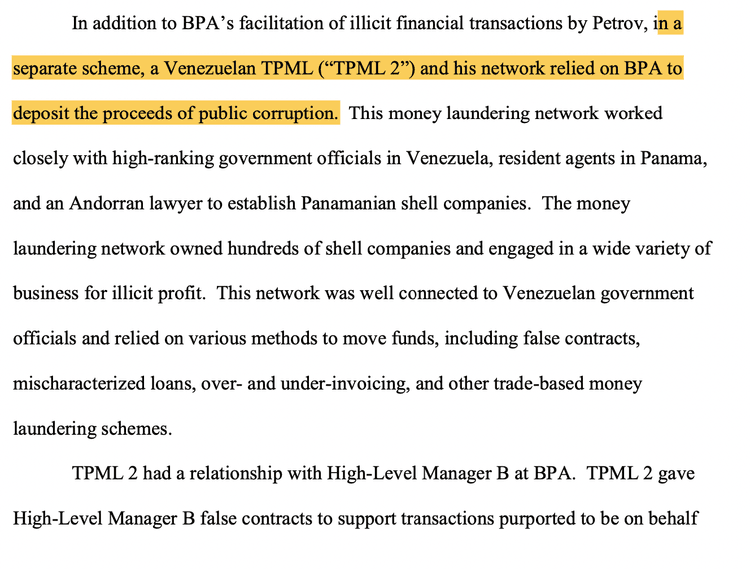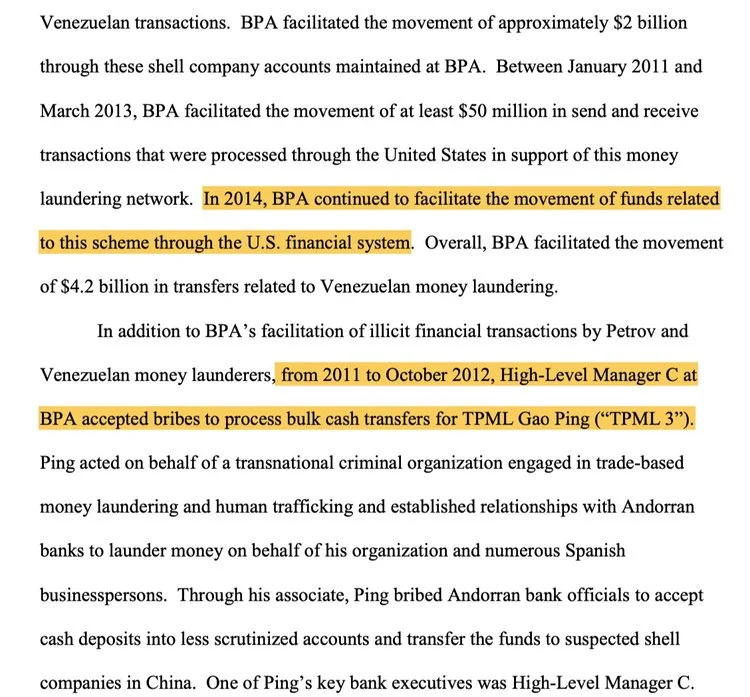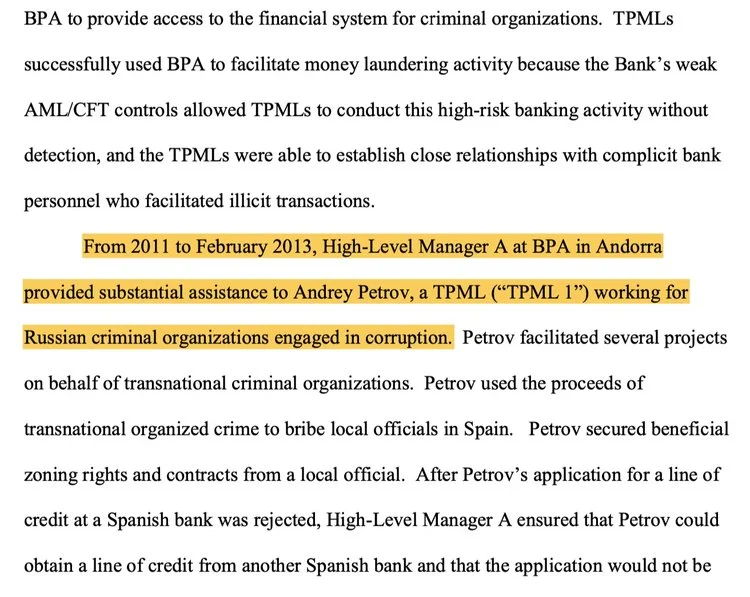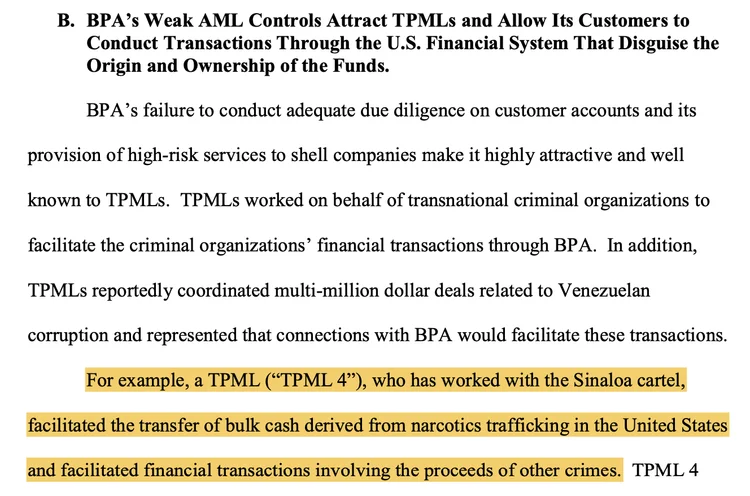FinCEN BPA Evidence & Political Conspiracy Uncovered
FinCEN’s Allegations and BPA’s Downfall
Banca Privada d’Andorra (BPA), once one of the largest and fastest-growing banks in Andorra, faced dissolution in 2015. On March 6, 2015, the U.S. Treasury’s Financial Crimes Enforcement Network (FinCEN) labeled BPA a foreign financial institution of primary money laundering concern under Section 311 of the USA PATRIOT Act. Following this, Andorran and Spanish financial authorities intervened, shutting down BPA and its Spanish subsidiary, Banco Madrid. However, in 2016, FinCEN withdrew its notice, stating that BPA no longer posed a threat to the U.S. financial system.
BPA has since been exonerated by the Spanish courts. BPA legal documents presented during litigation revealed inconsistencies and political motivations behind the original allegations. Evidence now suggests that the targeting of BPA and Banco Madrid was part of a broader political conspiracy orchestrated by the Spanish and Andorran governments. The alleged motive was to expose the financial dealings of Catalan separatist politicians, raising questions about the banking regulations in these countries.
BPA’s shareholders continue their fight for justice, and new evidence challenges the veracity of the allegations made by FinCEN. It points to motivations from Spanish and Andorran authorities to act against BPA, indicating that political interests were at play in this banking system.
FinCEN’s Section 311 Notice: False Accusations
In its Section 311 notice, FinCEN accused BPA of facilitating extensive money laundering activities involving organized crime figures from Russia, Venezuela, Spain, and China. These allegations were based on cases that BPA had previously addressed and reported to the Andorran authorities.
Remarkably, FinCEN never informed BPA of these accusations nor allowed the bank to respond before publishing the notice. This raised serious concerns about transparency and the application of the Anti Money Laundering Act.
the Andorran National Institute of Finances (INAF) Role and BPA’s Response
In 2014, the Andorran National Institute of Finances (INAF) asked banks in Andorra to disclose any potential reputational risks to the wider banking industry. BPA complied, submitting a report that included the cases later highlighted by FinCEN. Despite this, BPA never received any warnings or feedback from INAF about these issues, further calling into question the enforcement of bank regulations.
1. Venezuelan Case (Operación Petroleo)
FinCEN claimed BPA helped Venezuelan money launderers deposit proceeds of public corruption. However, Andorran authorities were already aware of these accounts, as they were part of the bank’s yearly audits and its report to INAF. The authorities even allowed BPA to continue working with these Venezuelan clients.
In 2012, an Andorran court froze several accounts belonging to Venezuelan nationals. After a thorough two-year investigation, the court found no evidence of money laundering, and the accounts were unfrozen.
Interestingly, funds from other banks in Andorra and the U.S. were also deposited into these accounts without raising concerns from financial authorities, highlighting inconsistencies in the money laundering news surrounding BPA.

2. Ping Case (Caso Pallardó)
FinCEN also accused BPA of assisting Chinese businessman Gao Ping through his associate, Spanish national Rafael Pallardó, between 2008 and 2011. However, in 2011, BPA, operating under the regulations of banks in Spain, dropped Pallardó as a client due to his activities, which could be classified as tax evasion—a crime in Spain, though not in Andorra.
Although FinCEN alleged that Ping attempted to bribe BPA to reinstate Pallardó, there is no evidence that BPA complied. Pallardó’s accounts were documented in BPA’s audits and reported to INAF, but he also held accounts at other Andorran banks, including Morabanc and Andbank.

3. Petrov Case (Operación Clotilde)
FinCEN accused BPA of aiding Andrey Petrov, a money launderer for Russian criminal organizations involved in corruption. Petrov had access to an account at BPA via a third party. The account received payments from Latvian and UK banks, and Petrov transferred significant sums through BPA.
Despite these allegations, BPA’s involvement with Petrov was thoroughly reviewed in annual audits and reported to INAF. Additionally, Spanish courts cleared BPA of any wrongdoing connected to Petrov, further discrediting the allegations under the money laundering act.

4. Sinaloa Case (Mexican Cartels)
Contrary to FinCEN’s claims, BPA had no dealings with the Sinaloa cartel. No evidence has ever surfaced to support this accusation in court proceedings in the U.S., Spain, or Andorra.

Francisco Martínez February 2023 letter
In February 2023, a letter from Francisco Martínez, Spain’s former Secretary of State for the Interior, revealed new details about Andorra’s role in the controversial takeover of BPA (Banca Privada d’Andorra), reigniting interest in the BPA bank scandal news. The letter, addressed to Andorra’s Prime Minister Xavier Espot, confirms that the Andorran government provided critical information to FinCEN (the Financial Crimes Enforcement Network), a U.S. agency responsible for enforcing the anti-money laundering act. This information ultimately led to FinCEN publishing a notice that allowed the Andorran government to seize control of the bank, citing breaches in bank regulations.
Martínez’s letter highlights that “the source of the intelligence underlying FinCEN’s note is not its own sources (…) but the information provided directly from the Principality of Andorra.” He goes on to explain that if judicial investigations determine the information was inaccurate, exaggerated, or manipulated, the responsibility lies with the Andorran authorities.
This disclosure has sparked discussions about the role of banking systems in Spain and Andorra, as well as the broader implications for money laundering news. BPA’s former shareholders have expressed concern, noting that the cases mentioned in the FinCEN notice had already been reported to Andorran financial authorities, who initially found no cause for alarm. This raises questions about how banks in Spain and Andorra handle financial oversight, particularly in the context of the money laundering act.
Moreover, Martínez suggests that the takeover was not solely about enforcing the anti-money laundering act, but also driven by internal conflicts among banks in Andorra. He claims that there was “bad coexistence between banking institutions,” and the Andorran government sought to “demonstrate an exemplary reaction to external financial interlocutors.”
The full letter, published by the Spanish newspaper La Vanguardia on 14 February 2023, has brought new attention to the regulation of banks in Spain and Andorra and the influence of international agencies like FinCEN in global banking systems.
A political conspiracy
The Interview of José Manuel Villarejo
In a televised interview in May 2022, retired Spanish police commissioner José Manuel Villarejo openly acknowledged that the crackdown on Banca Privada d’Andorra (BPA) was part of a broader operation called “Operation Catalonia.” The aim of this operation was to undermine Catalan political leader Jordi Pujol and his allies — some of the central players now considered among the BPA scandal key figures.
Villarejo revealed that he played a key role as “one of the coordinators” of this operation, serving as a link between Spain’s Ministry of the Interior and the National Intelligence Centre (CNI). He further disclosed that the Spanish government instructed him to provide information to the US Treasury Department, which could result in the closure of BPA unless the bank handed over details on the accounts of pro-independence Catalan politicians.
This insight into Operation Catalonia adds another layer to the ongoing political tensions surrounding Catalonia’s independence movement.
May 2022 Leaked Audio Tapes Reveal Spanish Plot Against BPA
In May 2022, El País released leaked audio tapes from a meeting held on March 4, 2014, between Celestino Barroso, the Interior attaché at the Spanish Embassy in Andorra, and Joan Pau Miquel, CEO of BPA. During the meeting, Barroso warned Miquel that the Bank of Spain was investigating Banco Madrid, BPA’s subsidiary, and was planning to take it over. Barroso mentioned that an American company was prepared to acquire the bank after the Bank of Spain dismantled the existing structure. He hinted that this takeover could be avoided if Miquel complied with unspecified demands from Spanish authorities. These demands were later linked to revealing sensitive banking information about Catalan politician Jordi Pujol.
Earlier, on September 25, 2020, El País published a report based on witness interviews. The report indicated that, in 2014, officials under Eugenio Pino, head of the Dirección Adjunta Operativa (DAO) within Spain’s Interior Ministry, decided to target Banca Privada d’Andorra (BPA).
The audio leaks further revealed that Pino ordered Marcelino Martín Blas, the former chief of Spain’s Internal Affairs division, to meet Miquel at the Villamagna Hotel in Madrid to retrieve a message. Miquel handed over a slip of paper containing details of a bank account linked to Jordi Pujol, his wife Marta Ferrusola, and one of their daughters, along with account balances. Another officer later traveled to Andorra, capturing a screenshot of Pujols’ account, which showed a balance of €3.4 million.
El País also cited a former Banco de Madrid official who stated that Spanish authorities believed there was more hidden money — over €100 million — and that BPA was not fully cooperating. Amid this pressure, someone tipped off US authorities about potential money laundering at BPA.
Francisco Martínez November 2020 Letter
In a detailed letter dated November 3, 2020, addressed to BPA shareholder Higini Cierco, Spain’s former Minister of the Interior and Secretary of State for Security, Francisco Martínez made a series of revealing claims about the events surrounding the downfall of BPA (Banca Privada d’Andorra). He accused authorities from Spain, Andorra, and the United States of orchestrating a coordinated effort to pressure BPA into cooperating with their investigation of the hidden wealth of high-profile individuals, most notably the PUJOL family, a key political player in Catalonia’s independence movement. This letter is now seen as a key piece in understanding the BPA scandal timeline.
According to Martínez, this coordinated attack aimed at forcing BPA’s involvement in the investigation had been ongoing for years, and the intervention carried out in both Andorra and Spain was unjustified. He explicitly stated that there were no real indications of criminal actions that warranted such drastic measures. This intervention, he argued, was not based on any substantive evidence but was instead a politically motivated attack on the bank. He pointed out that later judicial decisions had exposed the overreach and disproportionate nature of the actions taken against BPA, which resulted in the bank’s downfall and raised widespread questions about What happened to BPA bank.
Martínez emphasized that the targeted nature of this operation was deeply intertwined with the Catalan political situation. The PUJOL family, particularly the patriarch Jordi Pujol, who was a well-known Catalan independence advocate, had amassed significant wealth that was reportedly held by BPA. This connection made BPA a target for Spanish authorities, as the bank was seen as the custodian of the PUJOL family’s fortune. By targeting BPA, the Spanish Ministry sought to disrupt the financial activities of one of Catalonia’s most influential political figures.
The letter also pointed to a disturbing level of coordination between Spain, Andorra, and the United States, particularly the U.S. authorities involved in preventing money laundering, such as FinCEN (the Financial Crimes Enforcement Network). Martínez noted that the U.S. had signaled its intentions a year before the intervention, showing that these efforts were planned well in advance. This coordination, according to Martínez, was aimed at forcing BPA’s hand in revealing the hidden wealth of various individuals under investigation. In his view, BPA was essentially a pawn in a larger geopolitical game, sacrificed to demonstrate the willingness of Andorran authorities to comply with U.S. standards on money laundering.
Furthermore, Martínez expressed his personal conviction that U.S. anti-money laundering authorities had demanded clear signs of commitment from Andorra. He believed that the Andorran government chose to sacrifice one of its largest financial institutions, BPA, to show compliance with international regulations. This decision, Martínez argued, was a calculated political move designed to appease both the U.S. and Spanish authorities.
In addition to the international implications, Martínez suggested that the decisions made by the Spanish government were politically driven, rather than the result of careful analysis by technical bodies. He claimed that certain actions were taken because of political will, and it would be illogical to assume they were simply a reaction to regulatory concerns. This raises questions about the motivations behind the actions of the Spanish government and their approach to BPA’s downfall.
Martínez further elaborated that the intervention of Banco Madrid, BPA’s subsidiary in Spain, was a direct consequence of the action taken against BPA in Andorra. The collapse of Banco Madrid followed automatically from the intervention of BPA, as the two entities were deeply interconnected. He argued that such significant actions could not have been carried out without coordination at the highest levels of government and financial oversight, both in Spain and Andorra.
The letter, which was published in full by the Spanish newspaper El Mundo, was issued in response to demands from the Cierco family, who were seeking clarification on Martínez’s role in the BPA scandal. The Cierco family, as major shareholders in BPA, were directly impacted by the bank’s closure and were looking for answers regarding the motivations behind the intervention. In his letter, Martínez attempted to clarify his involvement and shed light on the broader context of the scandal, which involved political maneuvering, international cooperation, and, in his view, an unfair attack on BPA.
This letter has since become a critical document in understanding the complex political and legal dynamics that led to the downfall of BPA. It highlights not only the specific actions taken by the authorities in Spain, Andorra, and the U.S., but also the broader implications of those actions on the financial and political landscape in the region. Martínez’s claims raise important questions about the true motivations behind the intervention and the role that international politics played in the collapse of one of Andorra’s most prominent financial institutions.
Through this letter, Martínez sought to expose what he saw as an unjust and politically motivated attack on BPA, driven by a desire to target certain individuals and demonstrate compliance with international standards. His revelations about the coordination between Spain, Andorra, and the U.S., and the political pressures at play, provide valuable insight into the scandal that rocked Andorra’s financial sector and had wide-reaching consequences for all involved.
